#gods of mesopotamia
Text

The coronation of the king of Assyria by the gods
The Assyrian king receives the insignia of power from the gods Aššur (Ashur) and Ištar (Ishtar).
Ashur is in front of the Assyrian king and Ishtar is behind him and puts the king's hat on the king's head.
Read More:
What does ashurbanipal name mean (Video)
What does ashurbanipal name mean (Text Post)
How does Ashurbanipal introduce himself (Text Post)
Follow my YouTube channel. Silent tablets documentary, short videos from ancient history.
Follow my Twitter.
Source:
Oracc
#archaeology#ancient mesopotamia#mesopotamia#ancient history#akkadian#ancient iraq#ancient assyria#assyrian#ancient empire#ancient assyrian king#history of mesopotamian kings#history of ancient assyrfia#god of ashur#god of ishtar#gods of mesopotamia
8 notes
·
View notes
Text
Sorry Aziraphale, but Mesopotamia Crowley? She's mine. You snooze you lose
#good omens#I was not joking about this being a Mesopotamia Crowley fan account#she's my WIFE#if Aziraphale won't treat her right by GOD I will#crowley#good omens season 2#good omens 2#ineffable husbands#aziracrow#aziraphale#Mesopotamia Crowley
397 notes
·
View notes
Note
All these anons are cowards. Bring on the Crowleys. How would you rate the Crowleys from most to least favorite?
No bc the amount of Asks I've gotten that are trying to bait me into not picking Crowley is CRAZY /pos
Y'all win, okay😭, jeSus
and uhhhh
I don't have a least favorite Crowley, I think
as for my favorites, it's a tie between Turtleneck Crowley / Cardigan Crowley / Too Fast For Me, Crowley / OH FLOWER OF SCOOOOOTLAND Crowley / Eden Crawly / Disco Tony and Bildad the Shuhite
oh, and Twinkliel, but idk if he counts as a Crowley

#ik I listed almost all the Crowleys#shutup#shUtup#Mesopotamia Crawly is also#god i just#I LOVE HIM SO MUCH OKAY#gos2spoilers#aneh answers#aneh wont shut up
699 notes
·
View notes
Text
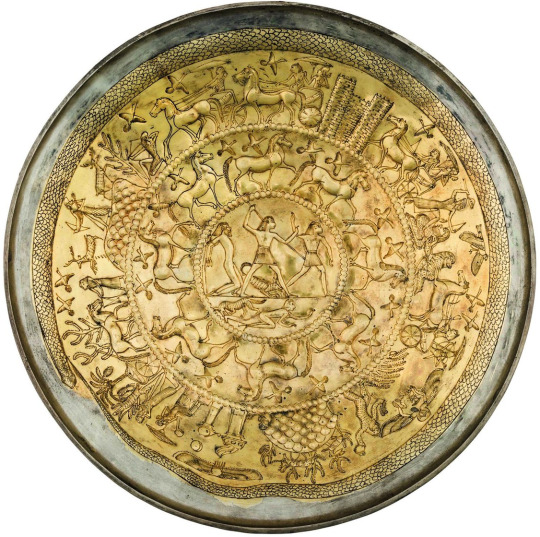

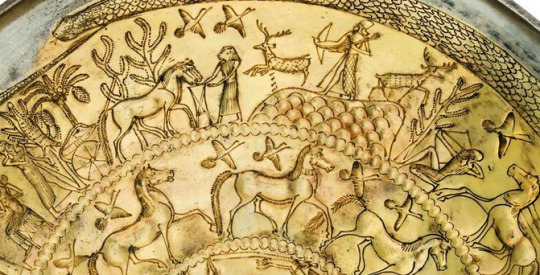

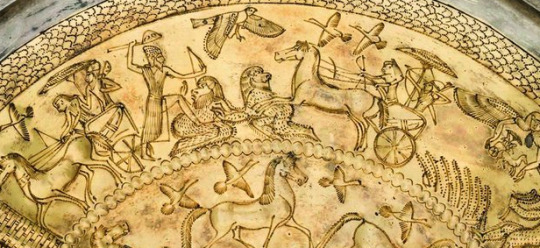
Phoenician Bowl with encircling Serpent
Bernardini Tomb (Palestrina, Italy)
c. 700 BCE
The National Etruscan Museum of Villa Giulia
Rome, Italy
#cyprus#rome#italy#egypt#egyptian gods#canaan#canaanite gods#phoenicia#phoenician gods#aram#aramean gods#syria#syrian gods#levantine gods#mesopotamia#mesopotamian gods#pagan gods#polytheism#archeology#magic#witchcraft#witchblr#paganblr#occult#uroboros#ouroboros#warfare#hunting#soldiers#birds
1K notes
·
View notes
Text
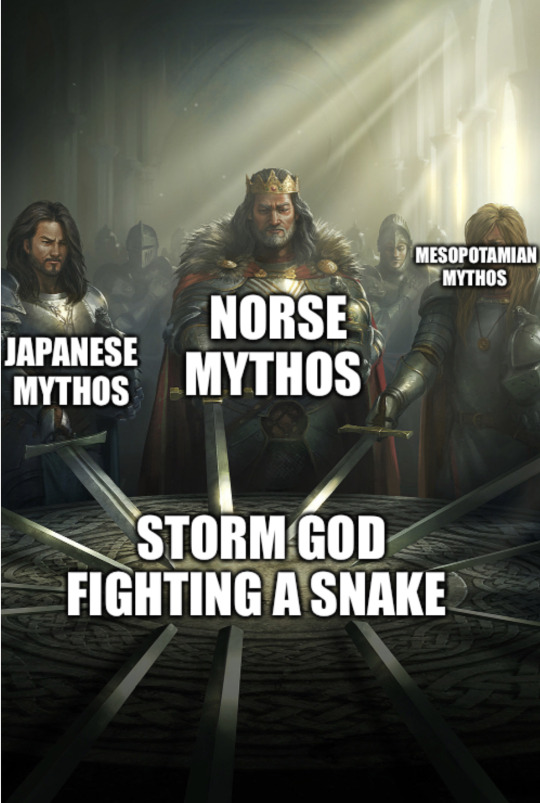
#mythology#mythology memes#norse mythology#mesopotamia#japanese mythology#memes#storm gods#sneks#really large evil sneks
58 notes
·
View notes
Text
Mythologic Geekery: Aphrodite

Alright, let me continue with Aphrodite. And she is super special. You know why? Because we know exactly where she came from, because her entire history is documented. We literally can trace her back to basically the very beginning. No comparative mythology needed
Part of the reason is, that she was just so god damn popular.
Aphrodite basically "descended" from the Phoenician Astarte. Astarte meanwhile was one of those universal goddesses. She stood for sex, beauty, healing, but also for war and hunting. She had a pretty big cult that spread into Ancient Greece, where she slowly was turned into Aphrodite.
Astarte, meanwhile, was influenced by Ishtar/Inanna from the Mesopotamian pantheon. Ishtar and Inanna are the same goddess, it is just that Ishtar was the semitic name given to her, while Inanna was the Mesopotamian and Sumarian name, with the later going back a lot further.
Inanna was associated with sex and beauty, but also with war and political power. And yes, there is some theories that Athena, too, was influenced by Ishtar as well. The semetic people also associated Ishtar as a "queen of the sky" and though already that the planet Venus represented her. So, yeah, that association goes back a long while.
Now, of course, pre-Mesopotamia we do no longer have written stuff about her. But we have enough idols found that it is pretty clear this mythologic entity was around before.
We are fairly certain, that she started out as a dawn goddess (as dawn was already something associated with Ishtar and Inanna), that hence already had the entire "beauty" thing going on, as both things were associated a lot. And because beauty and sex are kinda linked, that was picked up soon enough.
Fun fact: Rapunzel from the fairy tale? Yeah, she is probably decendent from the same dawn goddess. Just that she over time got divorced from her godly context.

#stray gods#aphrodite#venus#inanna#ishtar#astarte#rapunzel#tangled#greek gods#greek mythology#greek pantheon#mesopotamia#ancient history
109 notes
·
View notes
Text
Someone on Tiktok was complaining about Leah Sava Jeffries casting as Annabeth and being like, "HAVE YOU EVER SEEN A BLACK GREEK?" "Black Greeks didn't exist back then"
Honestly this pisses me off on a Whole new Level because the somewhat natural Progression of every Riordanverse lover is that eventually you start to like Mythological and Historical related stuff, like God of War, Hades, Overly Sarcastic Productions, Epic:The Musical, etc. But this person did not go through this and also because apparently, they think that African Greeks didn't exist.....
African Greeks have existed since Antiquity and the majority of Modern Black Greeks came from Sudan, as the Ottoman Turks bought their Ancestors who were slaves to Avato, a settlement in the Xanthi regional unit of Greece.
So Black Greeks exist, the Greek Gods could be Black idk considering that it's generally believed that Athena is not just Greek Goddess but also influenced greatly by Inanna, an ancient Mesopotamian goddess of love, war, fertility, divine law, and political power and Anat, Canaanite Goddess of war and hunting.
So the Greek Gods are a Mixed bag of many cultures, singling them out as Greek Solely is kind of missing the point.
#pjo#athena#pjo athena#pjo tv series#pjo annabeth#annabeth chase#leah sava jeffries#black greeks#afro greeks#african greeks#percy jackson and the olympians#greek tumblr#greek gods#greek mythology#ancient greece#mesopotamia#canaanite#mythology and folklore#greeks#greek history#african history#historical context#historical
35 notes
·
View notes
Text
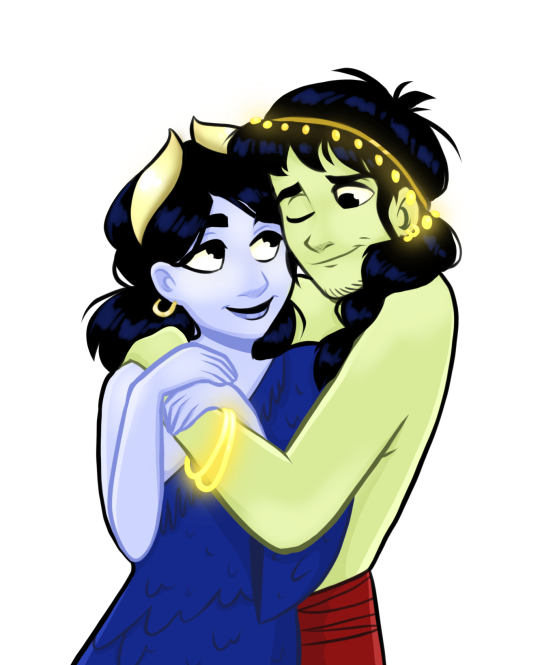
#ereshkigal#ereshkigal art#nergal#nergal art#mesopotamia#sumerian mythology#sumerian#gods#sumerian gods#art#My art#digital
24 notes
·
View notes
Text
ACTUAL Mesopotamian Pagan Goddesses You Can Work With INSTEAD Of Lilith 🌙

So if you've seen the old post of mine touching on an antisemitic "Demonolatry" subreddit, you'll probably have heard about the common argument antisemitic practitioners make to try and justify appropriating Lilith and a lot of other Jewish daemons.
A lot of these people will try to propose that working with Lilith isn't cultural appropriation, because she predates Judaism and is actually a "MeSoPoTaMiAn PaGaN gOdDeSs". And I don't think it takes a genius to realise that this is absolute horse shit lol. Just look at any Mesopotamian deities list and she's not there.
These people are most likely referring to similar spirits such as Lamashtu, Kilili, Ki-sikil-lil-la-ke, Ardat-Lili, and even Inanna/Ishtar in some instances. There's also the family of desert-dwelling night spirits that comprise of the Lilu and the Lilitu/Lili daemons.
While Lilith may have originated from or was based off of these daemons, they are not the same as Lilith. And I get that people have their own UPGs on certain entities being aspects of one another and such, but if that entity is part of a closed practise, you are in no place to even have a UPG on them to begin with. It comes from a practise that you aren't a part of, therefore you have no right or reason to have a UPG on it. Please just leave closed practices alone.
To my knowledge, one of the first times Lilith was documented was in the Dead Sea Scrolls, along with the daemon race of Lilin. The Dead Sea Scrolls is a Jewish/Hebrew text. So the idea that Lilith predates Judaism is just not true, and it's clearly an excuse made by people who appropriate her in an effort to brush off any accusations of their cultural appropriation and covert antisemitism. Lilith and the Lilin are only loosely based on the Lilitu wind spirits; They are not synonymous with one another. Anyone who tries to claim they are is just blatantly uneducated and/or antisemitic.
The whole idea of Lilith having origins in Mesopotamian mythology can all be traced back to a mistranslation. The BS-Free Podcast has an episode on this and it goes into depth about this mistranslation. I highly recommend checking out their podcast episode here!
⭒☆·━━━━━━━•( 🌑 )•━━━━━━━·☆⭒
In an attempt to combat some of this antisemitic fuckshit, I wanted to make an entire blog post dedicated to the goddesses and daemonesses of ancient Mesopotamia that you can work with instead of Lilith! I've had this idea for a little while now, but didn't really know who to include or how to construct this until now.
I also have another post in the making which will be a more UPG based post and will also include sigils, conjuration chants, correspondences, illustrations, etc. This current post merely exists to function as a guide and a sort of directory, with mostly historical information about each spirit listed.
So without further ado, let me show you some of the other goddesses, daemonesses, and spirits you can work with; All without appropriating someone else's ethnoreligion!
Full post is under the cut. ↓
⭒☆·━━━━━━━•( 🌑 )•━━━━━━━·☆⭒
☣️ DISCLAIMER: Some of these spirits may be considered intense, unpredictable, and chaotic in nature. These spirits can be overwhelming to work with if you are sensitive to such spiritual energies. Please tread with caution, especially if you're a beginner practitioner. Stay safe. Xx
⚠️ TRIGGER WARNING: Mentions of infant/child d3ath, ab0rti0n, and slight mentions of s3xual a55ault/abu5e and r4pe but nothing described in any explicit detail. Also slight mentions of antisemitism and Ne0-Naz1sm towards the end of the post.
⭒☆·━━━━━━━•( 🌑 )•━━━━━━━·☆⭒

⭒☆·━━━━━━━•( 🌑 )•━━━━━━━·☆⭒
Here are some ACTUAL Mesopotamian Goddesses and Daemonesses that can ACTUALLY be considered Pagan. These spirits, in my opinion, seem to bear the most resemblance to the pop-cultural stereotype of "Lilith".
⭒☆·━━━━━━━•( 🌑 )•━━━━━━━·☆⭒
+: Kilili :+
Lady Kilili is a daemoness of Sumerian origin, likely associated with owls. She is also attested as a minor goddess who functioned as a servant of Inanna/Ishtar.
-
Lady Kilili's name is that of a bird, most likely an owl. In one source she is equated with ab-ba-su-su, meaning "she who leans on the window" in Sumerian. She could be referred to as "queen of the windows" and "the one of haunted places", and it's assumed that she was imagined as an owl daemoness.
-
Kilili was usually affiliated with Ishtar, and according to at least one source, is said to be one of her eighteen messengers. She could also be considered as having a connection to sex due to her link with Ishtar. Kilili could also possibly have links with Lady Ardat-Lili due to similar affiliations, but there is no solid evidence for this.
-
It has also been theorised that Queen Kilili is in fact the goddess figure depicted in the Burney Relief terracotta plaque, and while it is highly likely, this has never been officially confirmed.
-
With the limited information we have on Queen Kilili, all we can really say is that she was likely a daemoness and goddess of owls, nocturnal animals, the night, sexuality, and portals to other worlds (hence the whole "windows" affiliation).
. . .
+: Lamashtu :+
Lady Lamashtu, also known as Lady Labartu, is a Mesopotamian daemoness and (demi)goddess who was said to menace pregnant women during childbirth, and allegedly kidnapped children and devoured them. She was blamed for Sudden Infant Death Syndrome, as humans didn't yet have a medical explanation for this phenomenon at the time.
-
She was the daughter of the Mesopotamian Sky God Anu. There are also modern day accounts of Pazuzu being her consort (the Daemon King of the Southwest Winds) and their offspring being the Lilu wind daemons. In my UPG, Pazuzu and Lamashtu seem to be friends with one another (or at most, in a queer-platonic relationship) but aren't necessarily espoused to one another. I do believe there are a specific subtype of Lilu wind daemons that were created by them though.
-
Lamashtu was also associated with ab0rting unborns and killing newborns, eating men and drinking their blood, disturbing sleep, bringing nightmares, allegedly harassing mothers and expectant mothers, infesting lakes and rivers, killing foliage, and being a bringer of disease, sickness, and death.
-
Queen Lamashtu was classified as an "evil" spirit, as she acted on her own accord rather than following the gods' instructions. However, it is likely that she was just a more chaotic spirit, as not everything in our world can simply be divided up into "good" and "evil". At least, that's what I believe anyways.
-
In modern times, Lamashtu could more so be seen as an advocate for ab0rti0n rights and women's rights, as well as a defender of women and neglected/abu5ed children, rather than being a malicious monster who kills without any motive.
-
As for the men she devours, perhaps we could suggest that these men were persecuting innocent women and sƐxually a55aulting and r4ping them, impregnating them with children the women did not want or were unable to care for. Lamashtu might then assist the woman with ab0rting the unborn child, and then guiding it to the afterlife or elsewhere to be potentially reincarnated.
-
She could also be seen as persecuting sƐxual abu5ers and protecting the victims or potential victims of such a55aults. I don't know, just some food for thought lol. A lot of the areas in which Ancient Mesopotamian religion was practiced had quite misogynistic attitudes towards women, being the time era that it was (obligating them to stay home and be wives); So perhaps Lady Lamashtu's mythos was somewhat twisted out of content because she didn't fill that stereotypical role. In a way, this could make Lamashtu quite the feminist icon!
. . .
+: Akhkhazu :+
Lady Akhkhazu, also known as Dimme-kur, is a Akkadian daemoness associated with pestilence. She is also called "the seizer".
-
Akhkhazu brings fever and plagues, and is a part of a trio of daemonesses (Labasu, Lamashtu/Labartu, Akhkhazu). Despite the fact that Akhkhazu is known as a masculine name, she is said to be feminine in nature.
-
Next to nothing is known of Lady Akhkhazu, however we can confirm that due to her link with Queen Lamashtu, she can be associated with death, destruction, and sickness. Being a daemoness of plagues and illness, it could be proposed that Akhkhazu may also be able to help heal these things.
. . .
+: Labasu :+
Lady Labasu was a part of the aforementioned trio of Mesopotamian daemonesses alongside Lamashtu/Labartu and Akhkhazu. She is said to have the same powers and associations as the other daemonesses in that trio.
-
Not much is known about Labasu outside of that, but we can assume that she's a daemoness of disease, plagues, pestilence, death, and decay. I believe she could also solely be worked with as a death daemon/deity.
. . .
+: Inanna-Ishtar :+
Lady Inanna, also known as Lady Ishtar, is an ancient Mesopotamian goddess of love, beauty, justice, war, and fertility. She is also associated with sex, divine law/justice, and political power. It was initially thought that Inanna and Ishtar were originally seperate deities, but overtime merged into the same deity (similar to how Amun and Ra merged to become Amun-Ra).
-
Inanna-Ishtar's prominent symbols were the lion and the eight-pointed star. She also had associations with the planet Venus. She held the title of the "Queen of Heaven".
-
Her spouse was Dumuzid (later known as Tammuz), the god of shepherds, fertility, and vegetation.
. . .
+: Ki-sikil-lil-la-ke :+
Lady Ki-sikil-lil-la-ke (also known as Kisikil-lila or Ki-sikil) is another obscure Mesopotamian daemoness of which not much is known about.
-
Her origins date as far back as 600 BCE, in the Epic Of Gilgamesh, an ancient Sumerian epic poem. In Tablet XII, an Assyrian-Akkadian translation of the latter part of the Epic Of Gilgamesh, it tells the story of a 'spirit in the tree' referred to as Ki-sikil-lil-la-ke. Proposed translations for the Tablet XII 'spirit in the tree' include; Ki-sikil as "sacred place", lil-la-ke as "water spirit, and lil as either "spirit" or simply "owl" (given that the lil builds its home in the trunk of a tree).
-
The Ki-sikil-lil-la-ke is associated with a serpent and a Zu bird. In the ancient city of Uruk, a huluppu tree grows in Inanna's garden, and she plans to use the wood of the tree to build a new throne. After ten years of growth, Inanna returns to the garden to harvest the tree, but finds that it has since been inhabited. A serpent is dwelling at the base of the tree, a Zu bird is nesting atop the tree raising its young, and the Ki-sikil-lil-la-ke has built a home within its trunk.
-
Gilgamesh was said to have killed the serpent, then the Zu bird flew away to the mountains with its young, while the Ki-sikil-lil-la-ke fearfully destroyed her house and fled to the forests.
-
Lady Ki-sikil's story was eventually mistranslated as referring to Lilith, leading to the misinformation of Lilith having origins in Mesopotamian mythology.
-
Outside of this, not much is known of Lady Ki-sikil. Going off the limited information we have of her, we can conclude that her associations are with willow trees, owls (or other birds of prey), water, snakes, forests, and vegetation in general.
. . .
+: Ardat-lili :+
Lady Ardat-lili (also known as Vardat-lilitu) is a Mesopotamian daemoness and wind/storm goddess who inhabits the desert. Not much is known of this daemoness, but in modern times she has been likened to a "succubus" or vampiric-like entity. Ardat-lili was said to prey on men and conceive daemon offspring from their nocturnal emissions.
-
There are a few different stories of Ardat-lili's origins. Some sources claim that she was the spectre of a young girl who died before getting married, and out of sheer bitterness and envy, she sets out to prevent and/or sabotage the marriages between mortals. Other accounts suggest that Ardat-lili may refer to a specific family of multiple spirits, rather than a singular entity. In my UPG, Ardat-Lili is a daemoness, whereas the Lilitu/Lili are a class of spirits that Ardat-Lili belongs to.
-
Ardat-lili is yet another daemoness of which little information is known, and it's likely that a lot of her mythos was lost to history. I personally interpret her as a daemoness/goddess of storms, wind, the desert, sexuality, and the night. I also see her as being androgynous, similarly to how I see Astaroth in my UPG.
. . .
+: Ereshkigal :+
Lady Ereshkigal (also known by the titles "Queen Of The Underworld" and "Queen Of The Great Earth") is the Goddess of Kur, the land of the dead in Sumerian mythology. In later myths, she was said to rule Irkalla alongside her husband Nergal. However, Ereshkigal and Nergal were only two of the many deities that ruled over the underworld in ancient Mesopotamia.
-
On some accounts, her name was given as Irkalla, similar to how the Greek name Hades was given to the underworld itself as well as the ruler of the underworld. Ereshkigal is also known by the name of Ninkigal, meaning "Lady Of The Great Earth".
-
In the ancient Sumerian poem Inanna's Descent To The Underworld, Ereshkigal was said to be the older sister of the aforementioned Inanna-Ishtar. But historically, they weren't commonly associated with one another. Another account associates Ereshkigal with the gods Ninazu (originally regarded as her husband but later as her son) and Ningishzida. It was said that Ninazu initially ruled over the Underworld, but Ereshkigal later fulfilled this role as the mythos evolved overtime.
-
In later Babylonian deity lists, Ereshkigal ruled over a category of Underworldian gods that were known as "Transtigridian Snake Gods" which included Ninazu, Tishpak, Ishtaran, and the Elamite god Inshushinak. She also had a messenger named Namtar.
-
Some accounts suggest that Ereshkigal and Inanna-Ishtar are somewhat polar opposites to one another; With Inanna-Ishtar being the Queen Of Heaven, and Ereshkigal being the Queen Of The Underworld.
-
. . .
+: Tiamat :+
Lady Tiamat (a.k.a. "The Glistening One") is the primordial goddess of the sea in Babylonian mythology. She represented the embodiment of primordial chaos, and was said to have created the entirety of the cosmos and the universe. with the help of her consort Abzu, the god of groundwater.
-
Tiamat's consort was Abzu, the god of groundwater. Together, they bore the first generation of deities, including their son Kingu. However, trouble arose when these gods kidnapped and murdered Abzu in an attempt to usurp his lordship over the universe. This angered Kingu, and he reported the incident back to his mother.
-
Devastated and enraged by her husband's death, Tiamat created eleven mighty monsters, including the first ever generation of dragons, whose bodies she filled with "poison instead of blood" and sent them to rage war upon the gods to avenge her husband. After war broke out, Tiamat was eventually killed by the storm god Marduk, and it was said that he integrated elements of her body into the heavens and the earth.
-
Tiamat is associated with sea serpents and dragons, and may have even taken the form of these animals sometimes.
-
Side Note: I actually wanna make a whole seperate post regarding the eleven monsters created by Tiamat, because I think they're really cool and I do wanna venerate them at some point!
. . .
⭒☆·━━━━━━━•( 🌑 )•━━━━━━━·☆⭒
Welp, that's pretty much it for this post! I will eventually be making a post about The Anti-Lilith-Appropriation Hierarchy Of Spirits I have come up with, comprised of all the spirits, goddesses, and daemonesses you can work with and venerate instead of Lilith. So stay tuned for that!
⭒☆·━━━━━━━•( 🌑 )•━━━━━━━·☆⭒
There are many different deities, daemons, and spirits that you can honour, worship, and venerate; Lilith doesn't need to be one of them.
Respecting closed practices is of upmost importance, because here's the thing... Spirituality and metaphysical beings cannot be definitely proven to exist. However, the years upon years of discrimination, erasure, xenophobia, religiophobia, and maltreatment in general that groups of people such as Jews and Muslims have had to go through, is very much real and can be backed up by solid evidence.
Do you really think it makes sense to prioritise something that could very well be all in your head, over actual oppressed minorities who have literally been mistreated and even killed since the very beginning of time, all because of shitty bigoted people's prejudices? Just think about that for a second.
Because if you still think it's completely fine to appropriate Lilith, even though it is evidently clear that she is closed and exclusive to Judaism (NOT Mesopotamian), then I have absolutely no problem assuming you're antisemitic and most likely a Ne0-Naz1 as well. And if you are, you should go and fuck yourself. :)
⭒☆·━━━━━━━•( 🌑 )•━━━━━━━·☆⭒

⭒☆·━━━━━━━•( 🌑 )•━━━━━━━·☆⭒
There's unfortunately quite a lot of antisemitism in occult spaces, especially when it comes to Satanism, Daemonolatry, and Luciferianism in particular. I want to do my best to counteract this shit and to help educate those new to this branch of the occult, so that unsuspecting people don't fall down an antisemitic pipeline like I did at the beginning of my path onto Daemonism and Daemonolatry.
If my best friend hadn't educated me on how bad cultural appropriation actually is and hadn't snapped me out of my radicalisation process, the gods only know where I would've ended up... It deeply concerns me just thinking about it. I hate to think about how antisemitic occult spaces such as r/DemonolatryPractices could've potentially led to me being radicalised into a Ne0-Naz1... Ugh, it makes me fucking shudder...
Please don't fall into the trap of thinking that cultural appropriation is completely fine and not harmful at all, because if you give that shit enough time to fester, you never know what it could snowball into. You'll most likely fall down a right-wing pipeline, and trust me, it is not a place you want to end up in.
I had to learn that the hard way.
⭒☆·━━━━━━━•( 🌑 )•━━━━━━━·☆⭒
Anyways, I hope you found this post helpful and informative! And as always, I wish you well on your spiritual journey. <3
~ May You Be Blessed By The Daemonic/Infernal Divine ~
-Kody
#daemonolatry info posts#pagan#paganism#demons#demonology#demonolatry#daemonolatry#daemonology#daemons#lilith#cultural appropriation#end cultural appropriation#end jewish appropriation#tw antisemitism#end lilith appropriation#stop appropriating lilith#antisemitism#antisemitsm tw#occult#paganblr#witchblr#pagan witch#baby witch#witch tips#mesopotamian daemons#mesopotamian demons#mesopotamian goddesses#mesopotamian gods#ancient mesopotamia#mesopotamian mythology
50 notes
·
View notes
Photo
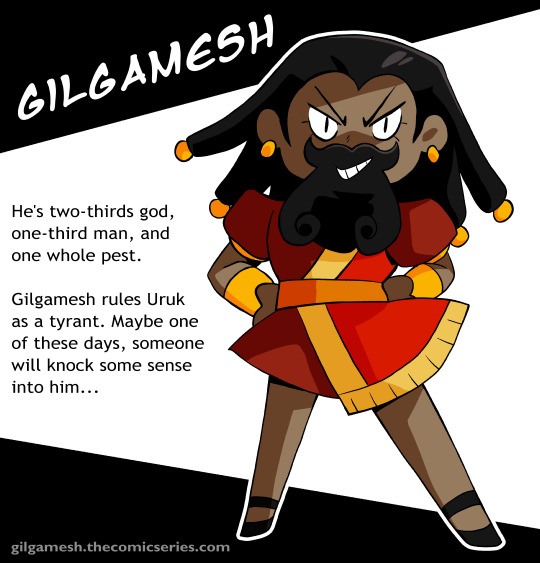
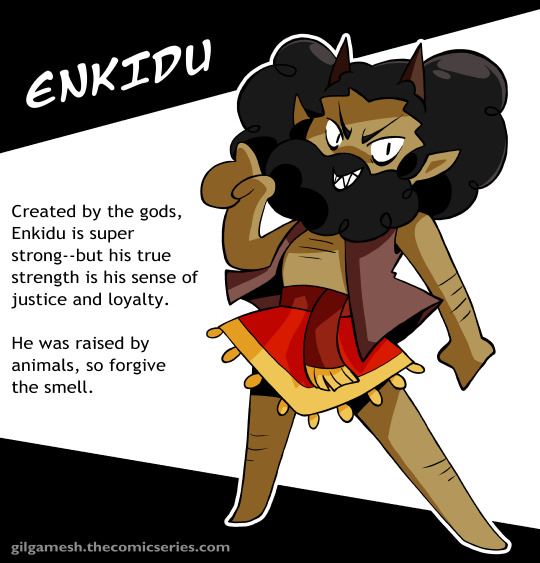

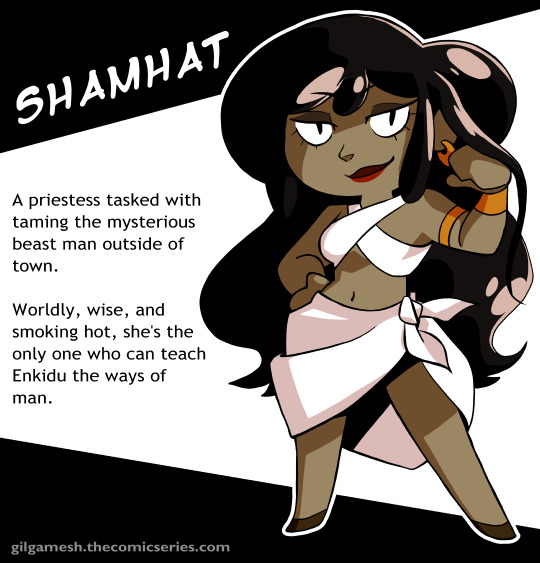
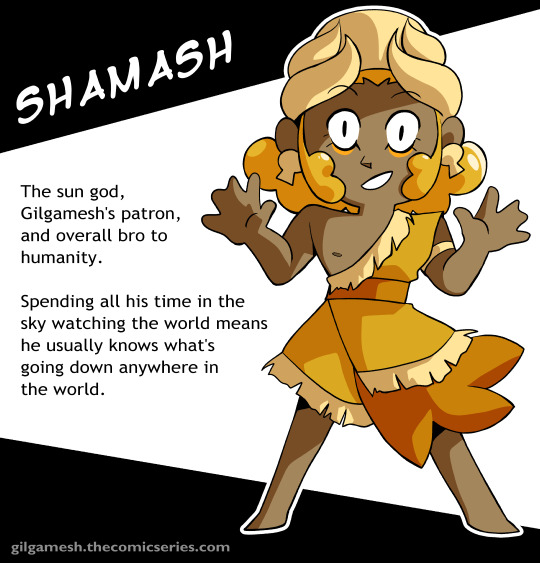
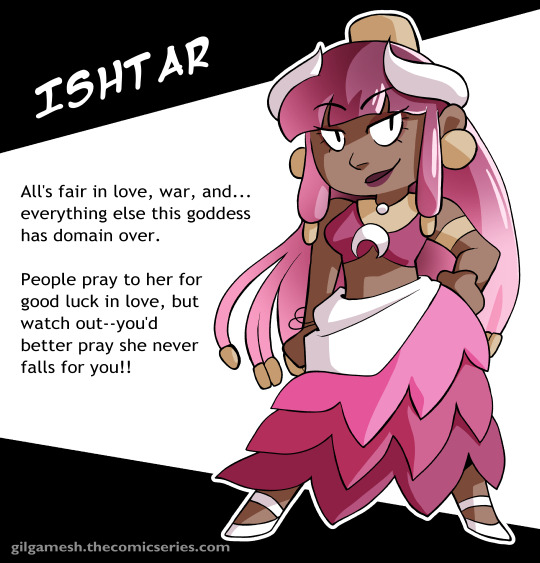
Some character bios!! I made these for the character page on the main comic website, so here, check ‘em out!!
(obvs these are just for the first half of the story, not going into spoilers here)
The Comic of Gilgamesh, starting this month!! On Comicfury and Webtoon!!! Tell your friends!
102 notes
·
View notes
Text
Okay guys this is a really serious intellectual meme, okay? I mean it. You need a lot of context about the translation history of the Epic of Gilgamesh to understand it. It is so smart. I know not everyone will get it but it is so funny. My super smart funny intelligent meme is below the cut okay? Are you ready?
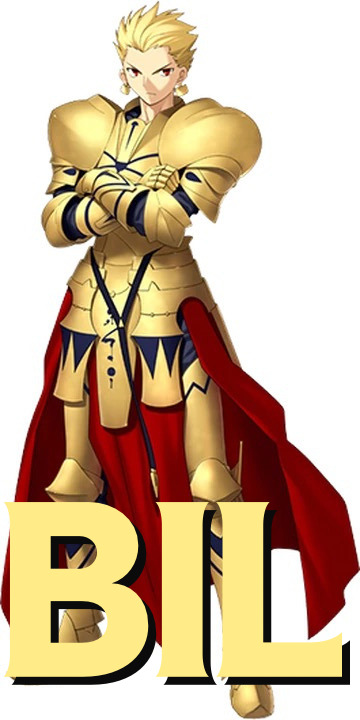
#i still hate his fate design#the epic of gilgamesh#ancient history#mesopotamia#babylon#chaldea#history#fate#fate grand order#fate series#fate go#gilgamesh shitposting#the… the epic of gilgamesh#gilgamesh#god i am so funny
9 notes
·
View notes
Text
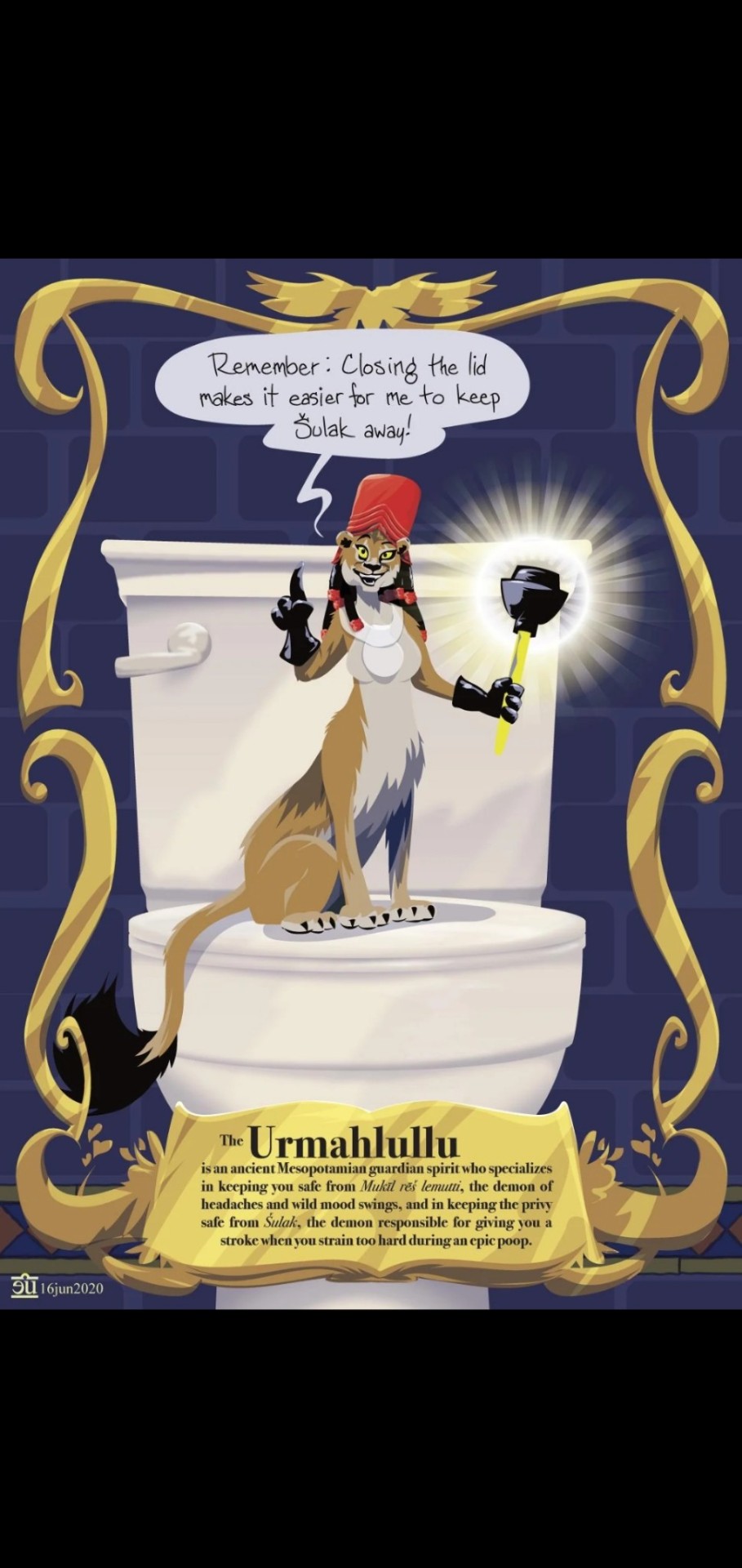
Saw this on reddit. Anyone else planning on doing more research on these guys ?
9 notes
·
View notes
Text
Namma/Nammu 𒀭𒇉
Sumerian Goddess, primarily from the city of Eridu
Mother of the Gods. *Creator of Mankind, specifically in Eridu, elsewhere this role went to Nintur or Ninmah
🌊 Information
From Gods Demons & Symbols by Black [Internet Archive Link]
How to use internet archive link
"Nammu was a goddess who was considered, in some traditions, to have given birth to An (heaven) and Ki (earth) and to many more of the more ancient gods. Especially she was regarded as the mother of Enki. She came to be thought of as one of the mother goddesses. Her name is written with the same sign as engur, a synonym of abzu, and it is probable that she was originally a personification of the subterranean ocean." [p134]
Dictionary of Ancient Near Eastern Mythology by Leick [Internet Archive Link]
Her name is usually written with the sign engur which was also used to write Apsu. In ancient times she personified the Apsu as the source of water and hence fertility in lower Mesopotamia. She may well have been worshipped in Eridu before Enki, who took over most of her prerogatives and functions. Significantly he was called the son of Nammu. In spite of her decline following the superiority of Enki, during the Neo-Sumerian period, at least at Ur, she was still considered important enough to have statues commissioned in her honour and she also features in the name of the famous king Ur-nammu. In mythology, Nammu appears as the primeval Mother-goddess in Enki and Ninmah who 'has given birth to the great gods'. She has the idea of creating mankind as a help for the gods and it is she who goes to wake her son Enki, asleep in the Apsu, that he may set the process going. [p 124]
Handbook of Gods & Goddess of the Ancient Near East [Google Books Link]:
"Namma: Sumerian goddess of the primeval, subterranean ocean. In the lexical series Diri the name has a syllabic rendering na-am-ma. In some traditions she was the mother of the sky god An, the earth goddess Ki, and a number of other deities. Enki/ Ea, the god of freshwater and wisdom, was considered her son. In the myth of "Enki and Nin-mah," when the other deities began complaining about how hard they had to work, it was Namma who awakened Enki from his sleep to urge him to create more creatures to take on the work of the gods. However, he delegated the task to Namma, who then received the credit for creating human beings. There was a shrine to the goddess in Marduk's great temple at Babylon, and at least one other of her sanctuaries is known"[p222]
Excerpt from Oracc [Link]:
"Very little is known about Namma, who belongs to the oldest generation of Mesopotamian deities and is associated with the pantheon of Eridu. She is mainly known for her role in the cosmogony of early Mesopotamia and her importance in magic, which is restricted to texts written in Sumerian [...]. According to the god list An-Anum, tablet I line 28 [...], Namma bears the title "mother who gave birth to the heavens and the earth. Because this goddess's name is written with sign for "(cosmic) subterranean waters" (Sumerian: engur) Wiggermann [..] has called her the "Cosmic Ocean. [...] In the Sumerian poem of Enki and Ninmah (ETCSL 1.1.2, line 17 link) Namma is called the "original mother who gave birth to the gods of the universe", again according her primary status among all the gods and describing her role in Mesopotamian cosmogony"
Section from Enki & Ninmah (ETCSL 1.1.2) [Link]
*Bolded part that explains her mother of Gods role, and also her creating man (different deities depending on myth)
*How deity, people, and place names are spelled is wildly inaccurate in the ETCSL, they don't even follow their own rules. But I still did not change the quote
"The gods said, weeping: "He is the cause of the lamenting!" Namma, the primeval mother who gave birth to the senior gods, took the tears of the gods to the one who lay sleeping, to the one who did not wake up from his bed, to her son: "Are you really lying there asleep, and ...... not awake? The gods, your creatures, are smashing their ....... My son, wake up from your bed! Please apply the skill deriving from your wisdom and create a substitute for the gods so that they can be freed from their toil!" At the word of his mother Namma, Enki rose up from his bed. In Hal-an-kug, his room for pondering, he slapped his thigh in annoyance. The wise and intelligent one, the prudent, ...... of skills, the fashioner of the design of everything brought to life birth-goddesses. Enki reached out his arm over them and turned his attention to them. And after Enki, the fashioner of designs by himself, had pondered the matter, he said to his mother Namma: "My mother, the creature you planned will really come into existence. Impose on him the work of carrying baskets. You should knead clay from the top of the abzu; the birth-goddesses will nip off the clay and you shall bring the form into existence. Let Ninmah act as your assistant; and let Ninimma, Cu-zi-ana, Ninmada, Ninbarag, Ninmug, ...... and Ninguna stand by as you give birth. My mother, after you have decreed his fate, let Ninmah impose on him the work of carrying baskets."
The Harps That Once by Jacobsen [Google Books Link]
"Namma, Enki's mother, was probably seen as the power in the riverbed which, empty or nearly empty in summer, gives birth to the fresh waters, to Enki, in the spring flood. This interpretation gains a measure of support from the fact that the cuneiform sign with which her name was written served also, if supplemented with the sign for "water," to write the word for "river." Etymologically the name Namma goes back to Nin-imma (nin-immaran-amma nama›namma) "lady female genitals," a personification of the numinous power to shape, mature, and give birth to the child, and it is as birth goddess generally, rather than as goddess of the riverbed, that the text here characterizes her. That latter aspect she may conceivably have acquired because the mythopoeic imagination conceived of the great gash in the earth which the dry riverbed presents as the genitals of Mother Earth herself, and the prototype of all female parts everywhere. Namma's role as birth goddess generally and as the one who gave birth to man probably represents a local tradition, perhaps at home in Eridu. Elsewhere it is the goddess Nintur, or Ninmah as she is called in this composition," [p 158]
From Wiggermann "Nammu" [PDF Link]
*He disagrees with Jacobsen on Nin-imma, but Wiggmann addresses many other authors both agreeing and disagreeing but its too densely written for me to even remotely understand the back & forth between the Assyriologists.
"Nammu is an ancient goddess of Eridu, who plays a part in the local (and early national) mythology as creatrix/mother goddess and as supporter of Enki in Magic. Most references relate to either of these two roles [...] Only her epithet "(^munus)agrig-zi-é-kur-(ra-)ke", "true housekeeper of Ekur" points outside Eridu to the pantheon of Nippur, but it may be due to a confusion with Nin-imma, Enlil's scholar and scribe." [p 137 Column 2]
🌊 Titles / Epithets
*I did not use š, ḫ, or ĝ when typing these for ease of reading. See Sisterofiris' posts on transliterations [link] & normalizations [link]. Page numbers correspond to Wiggermann's Nammu PDF, linked above.
🔹Amaùtuanki — "Mother who gave birth to Heaven and Earth" (p137 column 2)
🔹Ama-palil-ù-tu-dingir-shár-shárra-ke-ne — "Mother, who gave birth to all the gods" [I kept dashes so it can be read] (p138 column 1)
🔹Amarhusheke — "Compassionate Mother" (p138 column 2)
🔹Amagal — "Great Mother" (p138 column 2)
🔹Agrigziékurrake — "True housekeeper of Ekur" (p137 column 2)
🔹Amadingirdingira | Modern— [Link]
"Mother of (the) Gods" in Sumerian
𒂼 — Mother, ama [Link]
𒀭𒀭— Many Gods, dingirdingir [Link]
𒀝 - "of" genetive case suffix, .a(k) [Link]
🌊 Iconography
She has no known iconography that has been found yet according to Oracc.
I made these tonight on my phone. Left has an ocean as its background to represent the "Cosmic Sea" aspect.
Its the Mesopotamian horned cap/crown of divinity then her name 𒀭 (diĝir) and 𒇉 (engur)
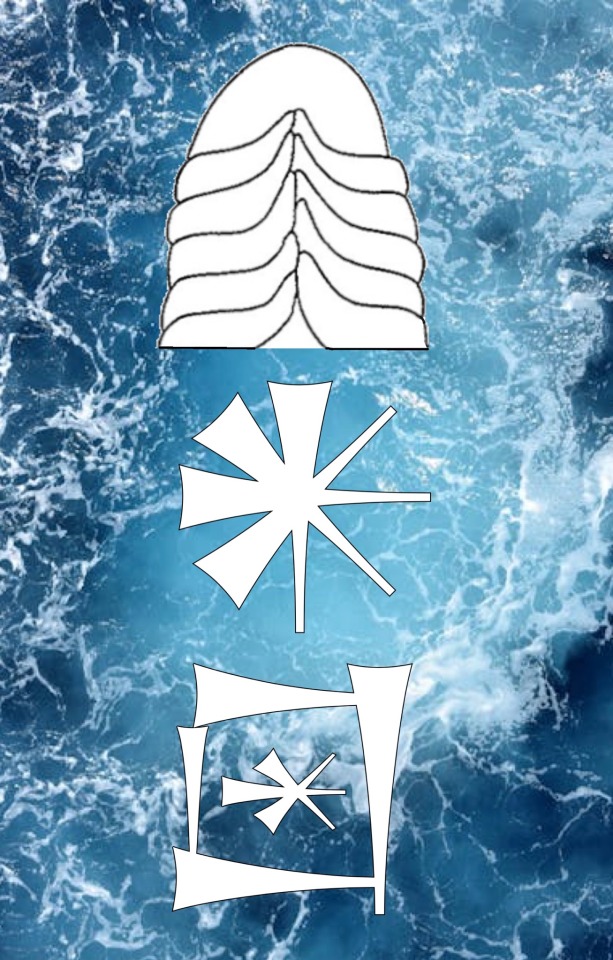

(click on right its not cut off as mobile shows)
#polytheism#paganism#nammu#namma#annunaki#sumerian#sumer#mesopotamia#mesopotamian#eridu#deity#deities#god#goddess#divine#mother goddess#primordial sea#levpag#cuneiform#cuneiform journey#deity resource#landof2rivers
5 notes
·
View notes
Text

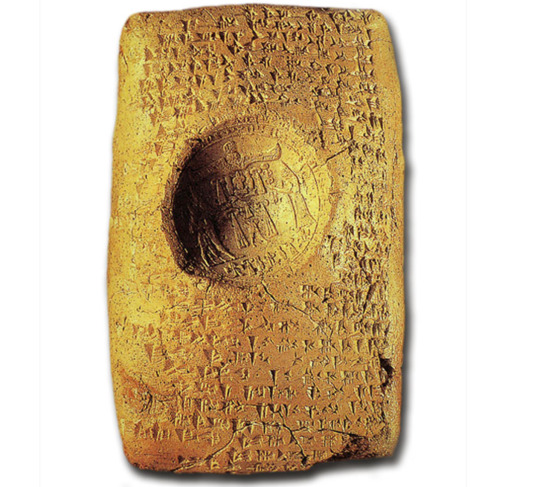
Divorce-Writ of King Ammistamru II
Ugarit, Syria
c. 1250 BCE
A tablet documenting the divorce of King Ammistamru II of Ugarit fromhattusa the daughter of the Amorite king Benteshina, sealed by the Hittite King Ammistamru. The king stands to the right, holding a spear, next to the "Weather God" who holds a club. They are both facing a long-robed female goddess (Arima, the chief Hittite sun-goddess) who stands at the left.
Source: Virtual Museum of Syria
#ugarit#hittite#baal#hadad#ugaritic costume#arima#sun goddess#huttusa#hittite gods#canaan#canaanite gods#phoenicia#phoenician gods#aram#aramean gods#syria#syrian gods#levantine gods#mesopotamia#mesopotamian gods#pagan gods#polytheism#archeology#magic#witchcraft#witchblr#paganblr#occult
271 notes
·
View notes
Text
The statue of Ebih-II echoes the fine and expressive artistry in ancient Mari and the belief that their leaders had a direct connection with the gods. This can be seen in their exquisite artwork, which is a cultural legacy of this ancient civilization.
34 notes
·
View notes
Text
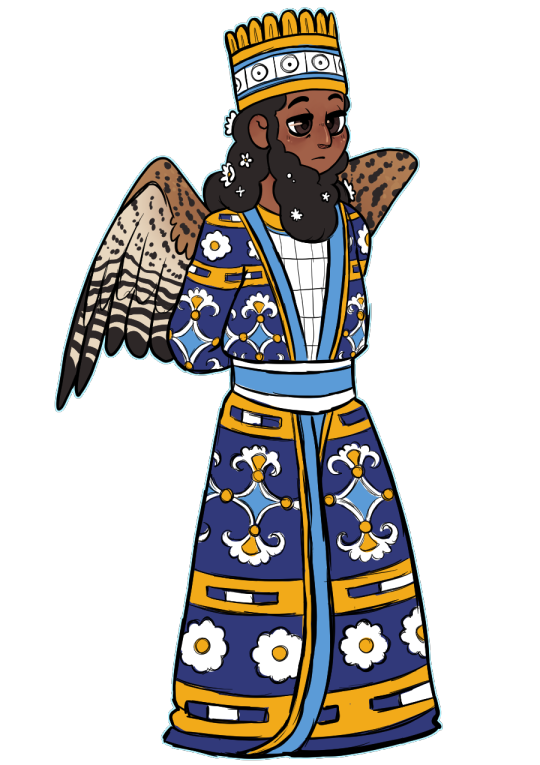

Marduk and Assur - Babylon and Assyria
Marduk and Assur are two Mesopotamian deities tied closely to their respective cities - Marduk with the city of Babylon and Assur with the city of Assur. In Pantheon, their destinies have been linked from early on, with their origins beginning in the Sumerian period…
The two deities are brothers, born at roughly the same time and sired by Enki, the famous god of the subterranean waters. Marduk, then named Asalluhe, was his child by Damkina, his wife, and therefore was more legitimate than Assur. Assur’s mother was an Amorite goddess that Enki was fooling around with, and given that Amorites were poorly looked upon by the Sumerians in this time period, Enki tried his damned hardest to conceal knowledge of said fooling around. Unfortunately, it’s more difficult to hide a godling baby that looks like you and has your family’s distinctive winged deity appearance, so he was left with a child that was for all intents and purposes unwanted.
Asalluhe and Assur grew up with disparate lives. Enki, not exactly known for his parenting skills, shoved his young sons off on other deities to raise them. In Asalluhe’s case, Utu the sun god was given the responsibility to raise one child. Dumuzi was given the responsibility to raise Assur.
Unfortunately, with Dumuzi’s proximity to Inanna, that didn’t bode well for Assur. While Asalluhe adored his “Uncle Utu” and changed his name to Marduk (calf of the sun) in appreciation, Assur moved away from the south as quickly as possible and returned to the outcrop of rock he’d been born at. The city of Assur formed around him, and as far as he was concerned, he was more than happy to stay far away from the south and all the bad memories it held.
As the climate changed, the southern Sumerian city-states dried up and Babylon came into power. With it, Marduk raised to power, finding himself beloved by the Amorite conquerors who took over Babylon. Marduk enjoyed kingship and power… until the gods of Hatti sacked Babylon and left him shattered. Damn Hittites didn’t even bother sticking around; the Kassite gods soon moved in and subjugated Marduk under their feet.
Assur fared hardly better. He built an impressive trade network, but his city fell into the control of the Akkadian Empire, the Kingdom of Upper Mesopotamia (Shamshi-Adad’s empire), and the Mitanni Empire. Only at the tail end of the Bronze Age did Assur start to regain his independence, enough to start challenging Hatti, Mitanni, and (Kassite) Babylon.
The Iron Age, though, is when the two really start to clash…
Illustrations commissioned from Eaglidots
#bronze gods#mythological fiction#pantheon#bronzegods#assur#marduk#mesopotamian mythology#mesopotamian-mythology#assyrian#babylon#mesopotamia#mesopotamian gods#lore#iconography
2 notes
·
View notes